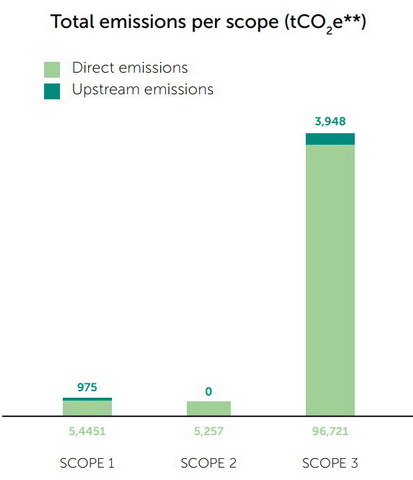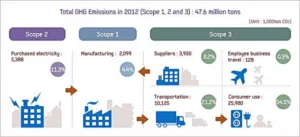Last month Best Buy issued a press release titled “Best Buy Accelerates Efforts to Combat Climate Change.” This got me to thinking about the display business and climate change.

My colleague, Norbert Hildebrand, has already written two Display Dailies on displays and climate change. The first, “Nobody Cares About Low Energy Consumption – But Maybe We Should,” looked at the energy consumed by displays and how the carbon emission from that energy will affect climate change. The second was titled “Does the Display Industry Defer or Accelerate Climate Change?” and focused on how increased energy efficiency doesn’t automatically translate into reduced energy consumption since the screens on TVs, smartphones and other displays continue to grow in size.
 According to Best Buy, their fleet of new Toyota Prius c hybrid Geekmobiles has already saved more than 140,000 gallons (530,000 Liters) of gas, the carbon equivalent of taking 263 cars off the road for a year. (Photo: Best Buy)
According to Best Buy, their fleet of new Toyota Prius c hybrid Geekmobiles has already saved more than 140,000 gallons (530,000 Liters) of gas, the carbon equivalent of taking 263 cars off the road for a year. (Photo: Best Buy)
As everybody knows, President Trump is an opponent of regulations that would reduce greenhouse gas emissions and slow the rate of climate change in the future. As part of this, he withdrew the United States from the Paris Accord, the world-wide agreement on greenhouse gas (GHG) emissions. Trump’s opposition comes from two sources. First, he doesn’t believe climate change is real, regardless of the near-universal consensus among scientists that it is not only real but has been caused by human intervention and will be a significant problem going forward. Second, regulating greenhouse gas emissions would involve regulations on industry and Trump is an opponent of this sort of regulation because he believes it retards economic growth and restrains innovation.
Do display companies agree with President Trump? Obviously Best Buy, a major retailer of display-containing technology in the US, does not agree with him. According to Best Buy their previous goal had been a reduction of greenhouse emissions of 45% and they have met that goal four years ahead of schedule. They have an accelerated target of a 60% reduction by 2020. This target represents a planned carbon reduction that is equivalent to removing 32,000 cars from the road for an entire year. They also say they are helping others reduce their carbon footprint by selling energy-efficient appliances including televisions and smartphones. This commitment to reducing the carbon footprint is not new and their corporate sustainability website includes a copy of their January 2014 statement committing themselves to reducing their carbon footprint.
Do other display companies agree with President Trump or with Best Buy? Since virtually every publicly traded company in the world has a sustainability statement on-line, I thought I’d look at a few and see.
Texas Instruments (TI) is a major US manufacturer of semiconductors, including the DLP series of imagers used in many projectors, including most digital cinema projectors. In their climate change statement, they say: “TI takes global concerns about climate change seriously. As a company, we are working to reduce greenhouse gas (GHG) emissions by developing new manufacturing technologies, using abatement devices and alternative chemicals, reusing chemicals and eliminating nonessential uses of perfluorocompounds (PFCs), which are critical to semiconductor manufacturing and are a significant source of our direct GHG emissions.”
TI adds, “As part of a 10-year, industry wide voluntary memorandum of understanding with the U.S. Environmental Protection Agency (EPA), TI reported PFC emissions to the agency, supporting a 10 percent emission reduction goal from a 1995 baseline through 2010. The semiconductor industry successfully achieved and far surpassed that goal.” If I read that right, TI has been working on reducing PFC GHG emissions since 2000,or maybe since 1995.
In terms of regulatory issues, TI doesn’t seem to be worried and says, “With the continued legislative and regulatory focus on developing new sources of power, while reducing energy consumption and emissions in coming years, our business opportunities in these areas (both near and long term) may likely escalate.”
 In addition to reducing its own GHG footprint, TI believes its semiconductor products will allow others to improve the energy efficiency of the power grid, electric vehicles and the smart home. (Source: TI)
In addition to reducing its own GHG footprint, TI believes its semiconductor products will allow others to improve the energy efficiency of the power grid, electric vehicles and the smart home. (Source: TI)
Barco is a major manufacturer of displays in Europe and ships these displays worldwide. In its Sustainability Report, part of its 2016 annual report, the company says: “Reducing greenhouse gas emissions at all Barco sites and departments is one of the key objectives of Barco’s sustainability strategy.” Barco has committed itself to reduce its CO2 emissions by 20% by 2020, compared to its emissions in 2015. They want to reduce emissions not only at Barco sites but also at customers and suppliers. As can be seen in the figure, emissions at Barco sites is only a small part of the total emissions Barco is willing to claim as its own.
 CC Barco’s estimates of its CO2 emissions. Scope 1 are direct emissions from Barco owned and controlled sources. Scope 2 is indirect emissions from Barco owned and controlled sources. Scope 3 are other indirect emissions from product use, product transport, suppliers and employee business travel. (Source: Barco)
CC Barco’s estimates of its CO2 emissions. Scope 1 are direct emissions from Barco owned and controlled sources. Scope 2 is indirect emissions from Barco owned and controlled sources. Scope 3 are other indirect emissions from product use, product transport, suppliers and employee business travel. (Source: Barco)
Barco estimates that about 51% of its GHG emissions are the result of its logistics. The company says “Reducing freight emissions is one of the focal points of our sustainability efforts in these initial years. Taking into account Barco’s growth, however, we expect freight emissions to increase in the coming years (+ 3% in total kms inbound/yr.). A solid plan to optimize transport worldwide will help us cut emissions in spite of that growth.” Their target for 2020 is to cut inbound logistics emissions by 15% and outbound logistics emissions by 13%. Since air freight produces large amounts of GHG emissions, Barco says they will use more efficient modes of transportation when possible – truck instead of airplane, train instead of truck, water transport instead of train. Since fuel consumption has been going down for both airplanes and trucks, Barco emissions for logistics are likely to decline even if Barco only modestly reorders its logistics.
I’m a projector person so I looked to see what Barco had to say about its projectors. “Our laser-illuminated projectors could reduce energy consumption of cinema projectors in Europe by 150 GWh per year – which equals the electricity production of a small nuclear power plant in one month. The use of laser projectors could [also] avoid over 1 million lamp swaps annually in Europe. This is the equivalent of 670 trucks filled with lamps navigating Europe every year.” Another good reason for laser projectors.
Of course, no one can take even the briefest view of any aspect of the world’s display industry without looking at Samsung. The company on its Climate Strategy website makes its basic position very clear: “Climate change is one of the most serious environmental threats facing our world. It is crucially important for all companies to reduce greenhouse gas emissions from business operations in order to protect the environment against climate change and achieve sustainable growth.
“Samsung Electronics has been establishing corporate-level strategies to address its direct and indirect impact on climate change. Through this, Samsung strives to reduce direct and indirect emissions of greenhouse gases and prevent potential risks by carrying out initiatives in voluntary GHG reduction and the development of an inventory.”
Given the serious threat of climate change to the world, Samsung is willing to accept government regulations to achieve reductions in GHG emissions. The company says: “Samsung Electronics recognizes that governments as well as companies have responsibilities to address the global challenges posed by climate change. Samsung Electronics supports global mandatory cuts of greenhouse gas emissions of at least 50% by 2050 (from 1990 levels) and mandatory domestic cuts by industrialized countries (Annex I countries of Kyoto Protocol) of at least 30% as a group by 2020. The company also calls for global greenhouse gas emissions to peak by 2015.”
Samsung Scope 1, Scope 2 and Scope 3 GHG Emissions for 2012 (Source: Samsung)
In the figure Samsung shows its emissions broken down by scope. Direct emissions by the Samsung manufacturing processes are actually a relatively small part of the total, only 4.4%. The bulk of the emissions (54.5%) come when the consumers actually use the Samsung-built products. In order to reduce this, Samsung must build more energy-efficient systems, including televisions. Second on Samsung’s list was transportation of its products at 21.2% of the total emissions. Like Barco, Samsung is likely to see a reduction here as more efficient airplanes, trucks, trains and ships are introduced. Samsung also points out that slim design and more compact packaging allows more product to fit in a single shipment, reducing the GHG emissions from transportation. For example, a 2008 Samsung 46” TV was 380mm thick and only 110 of them could fit in a truck. In 2011, a similar 46” TV was only 130mm thick and, with redesigned packaging, 384 of them could fit in the same truck.
Since 2015 has come and gone without a GHG peak (they continue to rise) and the analysis of Samsung GHG emissions dates to 2012, I wonder about how current Samsung has kept their Climate Strategy sustainability page. Hopefully they take sustainability and GHG emissions seriously and a sustainability page it isn’t just a corporate “must have” without any real effect on corporate policy or emissions. The alternative interpertation is Samsung recognized the dangers of climate change early and has been working on them ever since.
There you have it: four out of four display companies whose websites I checked have made serious commitments to greenhouse gas reduction and none of them have complained that GHG regulations have stifled innovation or reduced growth. In fact, they have discussed how GHG reductions have fostered and encouraged innovation, leading to new, more energy efficient products and ways of doing business.
I did check one non-display company’s website: ExxonMobil. They are the 5th largest oil company in the world and the largest in the US by 2015 revenue. In their Position on Climate Change they say: “The risk of climate change is clear and the risk warrants action. Increasing carbon emissions in the atmosphere are having a warming effect. There is a broad scientific and policy consensus that action must be taken to further quantify and assess the risks.” No climate change deniers there, either although I notice they are talking about quantifying and assessing the risks, not reducing them. Still, that’s something for an oil company. –Matthew Brennesholtz

